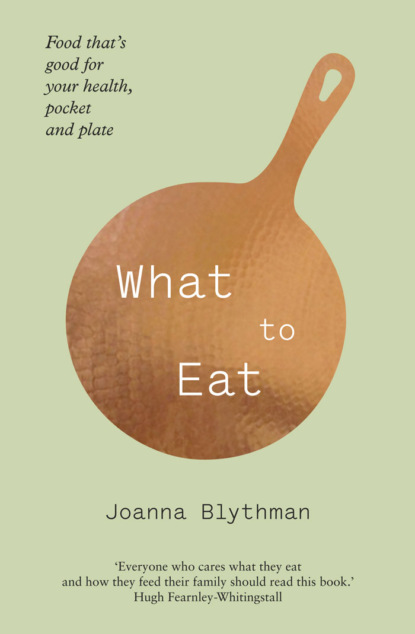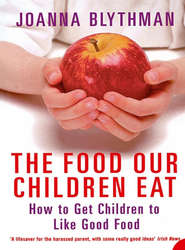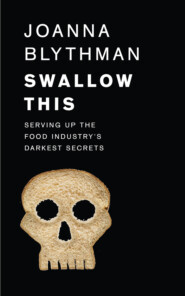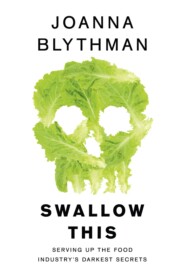По всем вопросам обращайтесь на: info@litportal.ru
(©) 2003-2024.
✖
What to Eat: Food that’s good for your health, pocket and plate
Автор
Год написания книги
2019
Настройки чтения
Размер шрифта
Высота строк
Поля
Be sceptical about nutrition advice from ‘experts’
The dietetic establishment has led us to believe that food is merely fuel and healthy eating is just a straightforward matter of calculating the number of calories we need for our body weight and activity level. Grub in, energy out. That’s all there is to it. This mechanical approach plays right into the hands of the food industry. Following this nutritional script, it doesn’t matter whether we eat technofood or natural food because everything comes down to a simple arithmetical calculation. Common sense alone dictates that there is more to food and eating than that.
Don’t hold your breath for learned, silvery-haired nutritionists to spell out the universal magic formula for healthy eating. Research into what constitutes optimum nutrition is best thought of as a work in progress, and anyone who tries to tell you otherwise is being simplistic and misleading. So instead, use your common sense. Base your diet on tried and tested unprocessed foods, studiously ignoring fads and showing healthy scepticism towards everything from top-down government health orthodoxy to the latest trendy diet.
These days, many foods come with an abundance of nutrition labels and supposedly helpful logos to help you assess the healthiness or otherwise of their contents. Mostly this is a confusing waste of time. Sometimes it is a deliberate red herring used by the manufacturers to bamboozle you and make you think a low-grade processed food is better than it might otherwise seem. Ignore nutrition labels and logos, and cut to the chase by looking at the ingredients label. Basically, the more ingredients listed, the more suspect the product is.
Don’t dismiss traditional food knowledge
Certain foods – beetroot, celery, raw milk, ginger, suet, garlic, yogurt, cabbage and carrots, for instance – figure in traditional medicine systems around the world as having beneficial medicinal and nutritional properties. It is currently fashionable to dismiss any such collective wisdom on the grounds that it isn’t ‘evidence-based’ – in the narrow, western, medical sense – and so little better than superstition. This is blinkered thinking. There is much to be said for the quasi-medical, nutritional knowledge that has been built up by different cultures and tested out and observed informally in human populations over time. When your grandmother told you that a hot honey and lemon drink would do you more good than any cough medicine, she wasn’t making it up. She was simply passing on the accumulated wisdom and experience of the generations that came before her. That knowledge is like gold dust.
Practise vegetable-centric eating
Of course, it doesn’t make sense to shut your ears entirely to ongoing discussions of nutrition, and there is some overlapping middle ground where otherwise diverse researchers and would-be authorities can agree. There is, for instance, no argument that vegetables are brilliant for you. It’s not just all the vitamins, minerals and soluble fibre that are beneficial; research is gradually identifying a number of phytochemicals, or natural compounds in vegetables, that are both health-enhancing and protective against disease. The early twentieth-century view, that vegetables were relatively unimportant in the diet because they consist mainly of water, has been radically revised. Currently, putting vegetables more at the core of your diet seems to be a key strategy for being healthy. Think in terms of vegetable-centric eating, where protein, fat and carbohydrate-based ingredients play second fiddle to vegetables, not the other way round.
Eat some protein
Realistically, you aren’t going to live solely on vegetables. A bit of protein still has its place, whether it’s from fish, meat, eggs, dairy foods or from vegan sources, such as pulses. Protein is emerging in research as the macronutrient most capable of satisfying hunger. As your grandmother might have put it: ‘It keeps you going.’ If you do eat protein in the form of meat, poultry, milk and eggs, try to make sure that it comes from free-range animals that have been fed on grass and other natural pasture foods. It will be better for you.
Rethink what you have been told about fat and cholesterol
That big bad dietary bogeyman – saturated fat – is being rehabilitated. Contrary to what we have been led to believe, there is an absence of evidence to support the nutritional mantra that fat is bad for health, or even to back the assumption that the naturally occurring fat that you find in whole foods is intrinsically fattening. Increasingly, the health benefits of natural saturated fat are being acknowledged. Saturated fats are key components of cell membranes and essential for the production of certain hormones. They act as carriers for important vitamins, and are needed for mineral absorption and lots of other biological processes. The ‘saturated fat is bad for you’ gospel is likely to melt away in coming years. This is one to watch.
Likewise, while we were once told authoritatively that foods that naturally contain cholesterol, such as eggs and whole, full-fat milk, were bad for the heart, this nutritional script is being hastily rewritten to concede that the cholesterol we eat in food does not lead to heart disease, and acknowledge that some dietary cholesterol is actually essential for maintaining health. Cholesterol is a vital element in our cell membranes. It’s no accident that human breast milk is very rich in the substance. Is it likely that nature would design a baby’s first food that was a killer?
Saturated fat and cholesterol found in natural foods such as butter and meat have a place in an aware diet. Man-made fats manufactured from artificially hardened, hydrogenated polyunsaturated oils, on the other hand, which were once recommended as the healthy alternative, have now been shown to be pretty lethal. This just goes to show how the nutrition establishment cannot be relied on for sound eating advice.
Cut back on sugar, sweeteners and refined carbohydrates
All nutritionists whose salaries aren’t paid by the sugar industry agree that sugar is a nutritional disaster. The main problem with sugar is that in its refined form we can consume huge quantities of it, in products such as drinks and sweetened fromage frais, almost without noticing. Unlike honey or treacle, refined sugar has no redeeming nutritional features. It’s difficult, because many foods that contain sugar are enticing, but there’s a strong case for keeping your consumption to a minimum.
A body of research suggests that high-fructose corn syrup, also known as corn sugar and glucose fructose syrup, a very modern ingredient now found in many soft drinks and a growing number of both savoury and sweet processed foods, is even more damaging to health than refined cane or beet sugar. Deeply implicated in the rise in obesity in the US, it is best avoided absolutely.
Don’t imagine that artificial sweeteners are better because they contain fewer calories. There is already research that suggests that these novel chemical concoctions actively encourage, not discourage weight gain. It looks likely that they will turn out to be very bad for us indeed, even worse than standard table sugar. Why give them the benefit of the doubt?
Fresh fruits contain a lot of natural sugar, but they also contain a number of phytochemicals, similar to those found in vegetables, that are thought to be extremely beneficial. So the sugar in fruit is not something to get worried about, unless you eat vast quantities, or are trying to control your weight.
All carbohydrate foods have the capacity to disrupt blood sugar levels. In their whole, unprocessed forms they at least contain some useful amounts of vitamins. But over-consumption of refined carbohydrates, such as white pasta, flour, rice, couscous and sugary drinks, is increasingly coming into the frame as being more fattening than fat, another probable cause of the obesity epidemic that is sweeping through affluent countries.
Make time to sit down at a table and eat meals
Satisfying your appetite is not just about what you eat, but also about how you eat. Sometimes the pace and pressures of modern life make us overlook this. If you bolt down food on the hoof, on your lap, upright in the kitchen, in bed or at your desk, your stomach may feel satisfied, but your brain and your emotions most certainly will not. If you make time – even just fifteen minutes – to sit down and eat a meal at a table, taking long enough to appreciate what’s on your plate, then your brain has the time to register that your stomach is full. Rushing food inevitably leaves you feeling psychologically unsatisfied by what you have consumed. In this state, you will be much more tempted to eat the next thing that comes into view and graze your way to obesity.
In all food cultures and over thousands of years, a certain ceremony and ritual has grown up around the whole business of eating. This is no accident. The act of eating is about more than simply filling the stomach. Meals have the capacity to make us feel nurtured, to nourish us emotionally and promote a sense of contentment that goes beyond any purely physical measure of wellbeing. If you can share meals with family and friends, then the pleasure of eating is further enhanced. But if you can’t, treat yourself like a worthwhile member of the human race anyway, and sit down to eat a meal at a table.
Boycott factory-farmed meat, poultry, eggs and dairy
Factory-farmed meat comes from livestock kept indoors in cramped, insanitary circumstances that create huge animal suffering. Factory farms are also incubators for diseases that affect animals and which can, in certain circumstances, spread to humans.
Factory-farmed animals are fed on vast quantities of cereals. These feedstuffs could be used more efficiently and less wastefully to feed humans directly. The planet simply cannot continue to produce meat, milk and eggs by rearing livestock in this way.
The availability of cheap, factory-farmed meat has encouraged many people to eat much more meat, poultry and dairy products than is good for health and to see large daily amounts as some sort of democratic entitlement. An overabundance of animal-derived foods in the diet isn’t healthy and, unless you are prepared to pay a small fortune, insisting on such quantities will necessarily mean that you end up eating cheap, inhumanely and unsustainably produced foods from miserable factory-farmed animals.
If you want to eat meat, poultry, eggs and dairy foods, buy less of them but maintain your spend by trading up to buy higher welfare, more extensively farmed, free-range, grass-fed products.
Adopt a ‘closest to home’ buying policy
It makes sense to favour food produced close to home. Of course, just because a food is locally produced doesn’t mean it’s good. A local chicken can be factory-farmed. The local baker can make lousy bread. But all other things being equal – the product tastes good and it has been humanely and ethically produced – then your food will automatically be fresher and more seasonal, and considerably less trauma will be inflicted on the environment in its transportation. The shorter the distance that food travels, the less energy is used. Transport relies heavily on oil, which is a rapidly depleting, non-renewable resource. A reduction in transport also helps bring down carbon emissions. By eating more local food, you can substantially reduce your carbon ‘foodprint’.
The money you spend on local food will support and encourage our native food producers, which strengthens communities and the economy and helps build our self-sufficiency in food. At the moment, we produce only 58 per cent of the food we eat, not a great situation to be in when we face a future where there will be more competition for globally sourced food resources and the energy costs of bringing imported foods to our shores will become greater and greater.
The supermarkets’ policy of treating the planet like one big global shopping basket has created a bizarre situation where many of us eat little or no local or regional food, and surprisingly small quantities of nationally produced food, even though we live in a rich and productive land and ought to be more or less self-sufficient. With the world’s population set to grow by 50 per cent by 2050, and global warming and a shortage of oil putting pressure on the world’s ability to feed itself, this dependency on imported food looks increasingly reckless. There is something fundamentally unsound about relying on faceless producers in faraway places to keep us fed, people who owe us nothing. Instead we need to make the country more resilient by buying more food that’s grown here, not flown or shipped here. What on earth are we doing eating Brazilian chicken, Dutch carrots, Danish pork or New Zealand onions? Are we crazy?
Another bonus of buying local food is that the production process – everything from the welfare of animals to the treatment of workers – will be much more transparent than that of foods that have travelled thousands of miles through the multiple links in an opaque supply chain. Let’s face it, shining a light into the dark highways and byways of industrial farming and food production is hard enough even within these shores. Suffice it to say that factory farms and food-manufacturing plants here don’t go out of their way to welcome us in for ‘Doors Open’ days. So what chance do we have of knowing what’s really going on in similar operations thousands of miles away?
Of course, we have been eating imported foods for centuries, and only the most pleasure-denying, hair-shirt-wearing eco-fanatic would seriously suggest that imported foods have no place on the plate. No chocolate? Or lemons? Unthinkable. Obviously, there is a list of foreign ingredients that few of us would like to live without, such as spices, olive oil, avocados, citrus fruits, cocoa, bananas and rice. We can’t produce them, and they enliven our diet immensely. These foods are not usually air-freighted, but generally shipped or trucked. There is no need to forgo them. Even those that are transported by air – Indian mangoes or lychees from Mauritius for instance – can have a small place in the diet as an occasional, exotic indulgence.
But then there are foods that we are perfectly able to grow or farm here, at least for some part of the year, but which are routinely brought in from all over the globe via a convoluted cold chain: fruits and vegetables such as green beans, blueberries, asparagus; and meat and dairy products such as lamb, pork, chicken and yogurt. There’s no need to have such foods supplied from abroad and their air-freighting, shipping and trucking, with its energy-intensive cold chain, is undeniably environmentally destructive. They almost invariably taste inferior to the native equivalent too.
Companies involved in the importation of fresh produce argue that the air-freighted trade in premium fruit and vegetables gives producers a much needed source of income, but any jobs created are precarious ones, based on a trade that is utterly fickle. Foreign workers can, and do, lose their jobs in a split second, at the whim of a supermarket buyer who decides to cancel a contract, or because transport costs make it cheaper to source food elsewhere. And in many places, crops are being grown for export at the expense of local people. In Peru, for instance, the production of asparagus is depleting the water resources on which local people depend. From Bolivia, there are reports that local people can’t afford to eat quinoa, their staple grain, because foreign demand has sent the price shooting up. What’s more, the dividends from such trade are more likely to end up in the pockets of wealthy elites than to stay with the people who do the work.
So rather than buying into the supermarkets’ ‘the food world’s your oyster’ proposition, apply a ‘closest to home’ buying policy. Make locally and regionally produced food your first choice, English, Scottish, Welsh and Irish your second, European and Middle Eastern your third and world your last.
When you do buy foreign foods, favour those with a Fairtrade label. It guarantees that producers get a more equitable, reliable price for what they grow and also means that their working conditions are better than most. Fairtrade allows us to build better relationships with foreign food producers, relationships that aren’t mired in exploitation and neo-colonialism. Fairtrade products aren’t prohibitively priced. You’re talking pence, not pounds, to support this more progressive type of world trade.
If you can, buy organic products too. The use of pesticides is less regulated outside the European Union and many workers have to apply them in risky conditions that would not be allowed here. They have to work and live in an environment contaminated with toxins to provide us with food. When you choose the organic alternative, you will know that the workers in distant places didn’t have to damage their health to produce it.
Get your food variety over the year, not in a week
Supermarkets have encouraged us to think that true variety is being able to buy every agricultural product on the planet 365 days of the year. This expectation is not environmentally sustainable. To add insult to injury, it is also extremely monotonous because the selection of food on offer doesn’t ever seem to change.
A more refreshing approach is to get your food variety over the course of the year, and let it be dictated by the seasons. This is how people used to eat. You feast on a glut of one thing when it is in season and eat it until it is coming out of your ears. Just when you are beginning to think enough is enough, it will disappear again to be replaced by some other food that feels refreshingly ‘new’ and this will often invigorate your cooking ideas. And so the cycle continues. This way, your diet is constantly changing and you will be eating food that suits the time of year and the weather: clementines at Christmas, asparagus in spring, berries in summer and sweet root vegetables in autumn and winter.
Don’t eat crops that trash the planet
Precious natural habitats all over the world are being cut down at an alarming rate to make way for large, intensively farmed plantations of soya and palm oil. Soya is used to provide the protein element in the feed of factory-farmed livestock. Both soya and palm oil are ubiquitous ingredients in thousands of common processed foods that we eat every day.
From the rainforest of Amazonia, through the Cerrado grassland savanna of central Brazil to the swampy tropical forests of Indonesia and Malaysia, these crops are powering massive habitat destruction. The impact on wildlife has been devastating. Magnificent species, such as the Borneo orang-utan and the Sumatran tiger, are now endangered because the habitat that sustains them is rapidly disappearing. These habitats are rich in biodiversity, not only in the form of animal and bird species, but also in plants. Such biodiversity is already alarmingly rare. We cannot afford to lose any more of it.
These vital habitats also act as massive carbon sinks, absorbing and storing potentially damaging carbon dioxide from the atmosphere. When these habitats are dug up to plant soya and oil palm, this carbon is released into the atmosphere, accelerating the pace of global warming.
Many people feel appalled by the destruction of our natural world, but feel powerless to do anything about it. One contribution is to stop buying products that contain soya and palm oil. Environmental groups have tried to set up systems to identify more sustainably grown soya and palm oil, but these have been hijacked by powerful companies active in these industries. For the time being, there’s good reason to strike both soya and palm oil off your shopping list.
Understand the benefits of organic food
Don’t fall for the line that organic food is just a trendy lifestyle choice for the neurotic rich. There’s nothing new or modish about organics. Until 1950, all the food we ate was organically produced. It is organic food that should be considered as ‘normal’ not the Johnny-come-lately, factory-farmed, industrial equivalent.
These days, there are many compelling reasons for buying organic food. It will almost never contain the residues of pesticides that are commonly found in food grown with the aid of agrichemicals. Just six pesticides are approved for organic farming and these can only be used in extremely limited circumstances. Conventional farmers have over 300 at their disposal and use them routinely. The powers-that-be parrot the food industry line that we should not be the slightest bit alarmed that our food regularly contains residues of toxic pesticides because they are all below ‘safe limits’. But pesticides are poisons. They are designed to kill things. Surely the only truly safe limit would be zero? Why eat toxins if you don’t have to?










